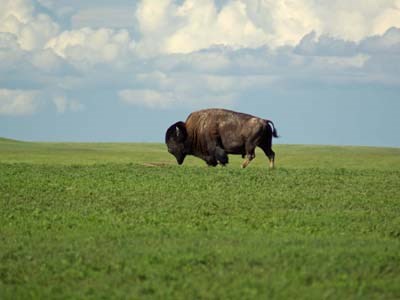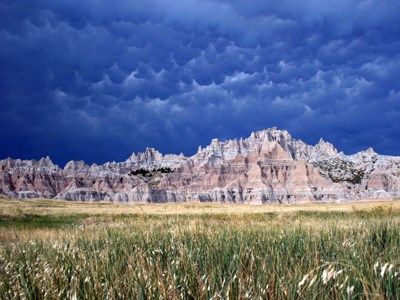Last updated: July 28, 2020
Article
Bison Bellows: Badlands National Park

NPS Photo/Badlands National Park.
The name "badlands" promotes a conceived image of a barren, desolate landscape. But there is nothing bad about Badlands National Park. In fact, it should be called "goodlands." For it is a landscape of full unique triangular buttes, orange and tan geological spires, expansive stretches of mixed grass prairie, and a herd of over 1,000 roaming bison.
Located in South Dakota, Badlands National Park is actually the birth place of modern day paleontology. The Badlands arose through geological forces such as erosion and deposition. When the first scientists traveled to the Badlands in the 1800s, they came across fossils from rhinoceroses, turtles, fish, and deer-like mammals. Today, Badlands National Park is home to one of the best preserved fossil records from the late Eocene and Oligocene time period.
Besides containing one of the most extensive fossil deposits, Badlands is home to one of the largest federal bison herds in North America. In 1963, two truckloads carrying 25 bison each traveled from Theodore Roosevelt National Park to the Badlands. The early stocking of 50 bison contributes today to the herd of over 1,000 animals. These bison are part of the metapopulation of federal bison. A metapopulation is a group of individual populations that are separated spatially, but consist of the same species. For example, the bison at Sully's Hill National Game Preserve, Rocky Mountain Arsenal National Wildlife Refuge, Fort Niobrara National Wildlife Refuge, and Badlands are separated by geographic location, but all make up a large federal herd (a metapopulation) of plains bison.

NPS Photo/Badlands National Park
Metapopulation management allows managers to relocate bison between federal, non-federal, and Tribal herds to help increase genetic diversity and viability of the species. Today, bison are found in small, fragmented populations and are unable to roam free across the Nation due to human land-use. If bison were managed separately in small herds, then the negative effects of inbreeding and isolation would be apparent. However, if separate herds are managed as one large herd, new genes are added to populations every time bison are removed and added to the herds during roundups. "Last year in 2014, we had the largest roundup in Badlands history of nearly 1,000 bison," said Eddie Childers, the Wildlife Biologist at Badlands National Park. "We donated 424 live bison to 8 American Indian Tribes to help populate their bison herds." This mixing of genes allows for populations to adapt better to their landscape and increase the ability to survive, reproduce, and fight diseases.
The Department of Interior (DOI) Bison Conservation Initiative recommends that bison herds contain 1,000 individuals or more in order to ensure the long-term viability of the species. Due to human development, it is not feasible to have 1,000 individuals in every public, private, and federal herd. Therefore, it is necessary to have many small populations contributing to one large metapopulation. Badlands National Park is one park that is working toward the DOI recommendation of 1,000 individuals. "There is currently an environmental assessment being proposed to expand the range by more than 20,000 acres to allow a large herd of bison to graze on approximately 80,000 acres in the park," said Eddie. "This range expansion will help us preserve the genetic diversity of bison as well as improve rangeland health and visitor experiences."
Did you know?
Since 1969, Badlands National Park has provided 4,782 live bison to over 29 Tribes from their annual roundup events. The Park collaborates with the Inter Tribal Bison Council to help restore bison on the Tribal lands.
